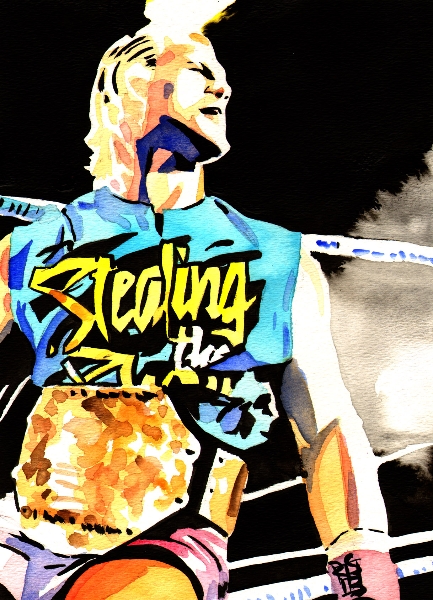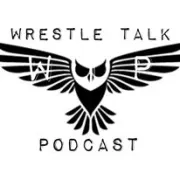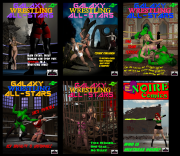Chapter 13: Believability and Chapter 14: Creating a Match By Matt Murphy
Posted by flairwhoooooo on December 14, 2009
We all remember the moment we learned there really was no Santa Claus. It was a little traumatic, but by then we kind of knew anyway and just needed to hear it said aloud, right? Wrestling fans have that same kind of experience when they learn wrestling is a work. But just like we suspend disbelief in Santa Claus at Christmastime (at least I do, Scrooge), we also do so when watching wrestling, movies, the evening news, and reality television.
Wrestling fans want to believe, even if just for a few precious moments. They want to get wrapped up in the drama. It’s no different than any other form of entertainment. To allow this, wrestling must be presented as legitimate competition and conflict. We have to make it believable.
The first step to lending believability to wrestling is not throwing stiff shots. Wrestling is a work — you are selling imaginary pain as legitimate. If you want to find out how tough you are, yell out, “Selena sucked!” at a Cinco de Mayo parade. Landing a stiff shot on a man who is standing there letting you hit him does not make you tough. It might impress Internet fans and writers, but when your opponent suffers an injury at your hands, you have not done your job no matter how many fans are on their feet at the end of the match.
What if I wrestled for WWE and I had a chance to work a dark match with you? If you threw a dozen stiff forearm shots that rattled my brain during the match, I’d think, I have to wrestle four nights every week. I’d be brain-dead in a month working with this idiot. If the Talent Relations rep sees potential in you and asks me what I thought about working with you, I’m going to say you were hard to work with and you might not get a job because of it. It’s nothing personal, but I have a family to feed and I wouldn’t want you around to put that at risk.
Many wrestlers don’t appreciate the long-term effects involved with taking shots to the skull: too many wrestlers rattle each others’ brains with striking blows. Sadly, there will be a lot more brain damage before wrestlers get over this stiff, wannabe-Japanese style. It’s easy to watch Japanese wrestling videos and imitate what you’ve seen, but I’ve worked with a couple Japanese guys whose years of taking stiff shots are evident in their slurred speech and vacant looks.
A good worked shot looks better than a real one, anyway.
The referee should be presented as the figure of authority inside the ring; you should work accordingly. One of the best things WWE has done for the business in recent years is give authority back to the officials (at least when it’s convenient for them). WWE sets the industry standard, and in this case we should all follow suit. If you don’t break a choke in the ropes or a double-team before the five-count, it’s a disqualification. If you don’t kick out before the three-count, you lose whether it was the planned finish or not. During a tag team match, each team can break up one pin attempt and after that they are disqualified for interference.
Do your part to work with the referee. When he wants to check you for foreign objects, you can debate for a few seconds with him, but let him check you. Don’t excessively break rules in front of him. If you’re not the legal babyface and you are distracting him while the heels double-team, make sure they are finished before you let him return his attention to the action inside the ring. Don’t put your hands on him. When you undermine his authority, you tell the fans that he’s a prop (a poorly used one, at that).
Another thing that adds a bit of realism to the business is emphasis on the rankings. It makes things seem more important and credible when each match affects the wrestlers’ positions in the Top Ten. It shows the fans what the wrestlers stand to gain or lose based on the match result, adding believability to wrestling.
Ask the average old-school guy how he feels about comedy in wrestling and he’ll tell you that there’s no place for it. I don’t completely agree, but I do believe that it should be done carefully. In order for comedy to work, it must be funny: most wrestling comedy I see isn’t funny. Comedy is usually done at the expense of believability, so do it in moderation and make it count.
I recently watched a Kevin Sullivan DVD from Kayfabe Commentaries where he recalled his favorite inter-gender match of all time. The match began, the man punched the woman, and she was knocked out. The end. I couldn’t agree more with Sullivan. Though Awesome Kong could probably beat up the average man, the general public still doesn’t believe that a woman can beat a man in a fight. If more than three-fourths of the human race believes something — fact or fiction — it’s as good as true. Thus, if a man sells for a woman in an inter-gender match, it’s detrimental to the believability of wrestling.
Effective selling makes people think you’re really hurt. When they see you at the convenience store after the match and you’re selling the same knee you sold during your match, they might buy the sell. Things like that add believability to the business. If you’re selling like the finishing move broke your neck and five minutes later you’re moonwalking to the autograph table, you insult the fans and crap on every match that follows.
To be believable, you have to believe what you’re saying, even if only while you are performing. I’ve seen wrestlers cut promos where I can tell they’re just pretending, and it’s annoying and not believable. You can’t expect to get the fans’ buy-in if you don’t buy it yourself.
Chapter 14: Creating a Match
There was a time when few things involving a match were discussed beforehand. The wrestlers just went out there and worked. Much of this was out of necessity, as the babyfaces and heels may have had separate locker rooms and entrances, leaving no way to communicate before meeting in the ring. Another reason they worked matches on-the-fly was because wrestlers liked to feel out the crowd to determine its needs as the match progressed.
These days, most wrestlers have every move, every hold, and every breath planned before they make their entrances. This is a bad idea. for many reasons.
As I said in an earlier chapter, great salesmen are great listeners. Let’s say you have this big spot-fest planned in the locker room. Your match begins, your first physical action is a simple lock-up, headlock, and headlock takeover: the crowd erupts. Why in the hell would you go through with the spot-fest? The crowd is already with you for simple wrestling, so there is why punish your body with big bumps or burn out the crowd with too many high spots?
When a public speaker who has every word memorized forgets a word, it throws off his whole speech—I’ve seen it and I’ve done it. The speaker struggles to find the word, then has to try to get back on track without losing his audience. The same applies with wrestlers. If they have a scripted match, any deviation from that script causes chaos. The best thing to do is to have a vague outline of the match in your head — what direction you want to go if things work out the way you expect — and fill in the spaces between.
Another reason why it’s important not to script your matches is injuries. During a match my rookie year, I was thrown into the position of leading an even greener rookie. I stuck to my training and didn’t talk out the match, save the comeback and finish. We were told to go twelve minutes, but three minutes into the match I spiked my foot on a backflip from the top rope (working barefoot, mind you), leaving my foot hyperextended and two toes dislocated. I had to structure the rest of the match to protect myself from further injury. Had we planned our match in advance, everything would have fallen apart. Instead, we had a decent match that the crowd loved and I didn’t make my injuries worse.
One of the biggest thrills of my career occurred during my first year, when I had a chance to work with one of my favorites, “Beautiful” Bobby Eaton. Before the match, I asked him what he wanted to do in the match. “I want you to keep your mouth shut and your ears open,” he said. Lesson learned.
#
There has to be a leader and a follower in a match. I had some really good matches with Trevor Murdoch, but I always called the match. That’s not because I was better than him, but it’s what worked for us. I was the heel, which is who should lead a match in most cases. If Trevor thought he needed a hope spot, he’d let me know and I’d call one if he didn’t already have something in mind. If I drew a blank on something, I would tell him and he would take over.
Calling a match, you should look like you aren’t talking to your opponent. Some wrestlers prefer to call a spot or move while in a hold, which is usually okay if there is motion to distract fans’ eyes from your moving lips. If I was on top, I worked the hold and the follower moved his hands and arms in his sell.
I also liked to call things during a spot. If the babyface was selling for me while I clamped down on a reverse chinlock, I might call a hope spot where he fights up to his feet, gives me a shot or two, and I would tell him to give me a belly-to-back suplex. While in the air, I would tell him to charge me and that I intended to move. After taking the bump, I would feed to the corner and sell to my feet while he summoned the energy to charge me for a big shoulder-block in the corner. I’d move, he would hit the turnbuckles and sell while I regained control of the match.
Cut out unnecessary words while calling. Talk like a caveman. Here’s a simple spot: John has a headlock on Bill. Bill shoots John into the ropes and John hits Bill with a tackle. John hits the ropes and Bill drops down. When John comes off the opposite rope, Bill attempts a hip-toss, but John blocks it and misses a clothesline. Bill gives John a schoolboy roll-up for a one-count. Bill comes up to his feet and is clotheslined down to the mat by John.
John is calling the match, so here is how he should call it. John has the headlock on Bill. He wrenches the headlock and pulls Bill closer to an upright position while working the hold (he doesn’t lean over to Bill to call the spot—he brings Bill to him). Tackle, drop-down, I block hip-toss, you duck clothesline, schoolboy me.
John continues to work the headlock while calling, the motion and Bill’s selling distracting people from the fact that John is calling a spot. They execute the spot, and when John is rolled up, Watch the clothesline. John kicks out, comes up to his feet, and clotheslines Bill.
I’ve heard people call the first part of the spot many different ways, some too wordy like, You shoot me off, I will come off the ropes and give you a shoulder tackle. You take a bump. I will hit the ropes, you drop down and try to give me a hip-toss. I will block it and throw a clothesline. You duck the clothesline and roll me up with a schoolboy. I will kick out and you feed up into a clothesline.
Calling in the ring is easy if you visualize the spot. You should have an imaginary television in your head, broadcasting the future event (the spot) in your mind as it’s being called. Bill is doing that, so when John calls the spot, everything plays out in Bill’s mind. He knows that he needs to shoot John into the ropes because they are in a standing headlock position. He also sees that, since he bumps off the tackle, it will be him dropping down when John hits the ropes again. It sounds obvious, but the first time you see two wrestlers’ testicles collide because each thought he was supposed to be the one doing a leap-frog, you’ll understand how visualization can prevent problems like that.
When you do put together a match, it is all about give-and-take. Don’t be selfish: your opponent needs to look good as well, and don’t sacrifice the greater good of the match because there is a move you really want to make sure you hit.
Before an event in 2002, I was approached by four men — my partner and manager and our two opponents that night — who all wanted to open the match with the babyfaces circling the ring and cornering our manager. We (my partner and I) would both hit planchas on the babyfaces. The two men who came up with the spot beamed and waited for my reaction, but their expressions changed when I bluntly said, “No.”
“Why not?” one of the idea’s creators fumed. “It’s a hot way to start the match.”
“Because we haven’t been to this town before,” I said, “so nobody knows who is the babyface and heel. These fans don’t know the whole story behind our feud. To them, the two biggest men in the match are about to attack a poor, defenseless manager and then the two smaller guys do these nice moves over the top rope. Who do you think they’ll cheer?”
It made sense to two of the men, but the creators tried arguing the point and I wasn’t budging. We didn’t do the spot to open the match, and the two who argued it were mad about it. To be diplomatic, I put in the spot after we had a chance to establish the babyface and heel teams and gave our manager a chance to work up a little crowd hatred for himself as well.
There will be times when even the best wrestlers have mental lapses and want to do something that doesn’t fit. Don’t be shy about questioning it. One wrestler I know does this effectively by objecting with a question. For the aforementioned spot, he would have asked, “Do you think the fans will cheer the heels if that happens? The planchas look nice and the manager has done nothing to instigate the babyfaces, so do you think we could do this as some other point in the match?” I always feared misunderstanding or mixed messages, so I was always more blunt and, for that reason, I was often the bad guy in certain situations.
Maybe you’re putting together the match and you feel like you’re not getting enough offense to look strong. You should address this issue. Just make sure you know your place on the card. If you’re working as enhancement talent (once known as a jobber) for WWE, that is not the place to bring it up because your job is to get squashed.
NEXT WEEK: Chapter 15: Match Structure
To order a print or Kindle copy (or to leave a review) of The Professional Wrestler in the World of Sports-Entertainment go to Amazon.com. You can also order a print copy of my first book, The Story of a Nobody and the Pursuit to Become a Somebody, at Amazon.
Be sure to check out content from my second book, I HATE IT WHEN … at http://ihateitwhentheblog.blogspot.com.
.









Leave a comment